I developed this model to help teams and organisations leverage the research available about collaboration in complexity and collective intelligence. It has been of great help to fast growing scale-ups and senior management teams in transforming incumbents. I hope it might be useful for you as well.
If you are managing a organisation in a stable market with no sign of disruption I would suggest that you check out FIRO, 5 dysfunctions of team or one of the other great collaboration theories created in, and for, the pre-digital world where homogeneous teams could create effect through division of labour and efficient execution on
However, if you are leading an organisation that aim to enter into new customer segments/markets, digitise your offering or if you are experiencing disruption in your industry, then this model offers a hands-on practical approach to how you can bring a diverse group together and create progress on complex challenges. It’s has been equally useful with executive management teams, as it has been with teams moving into a “agile” organisational set-ups.
You can read about the results in this Harvard Business School case study where Amy Edmondson describes what happened when I helped a team at a multinational corporate bank put it to use.
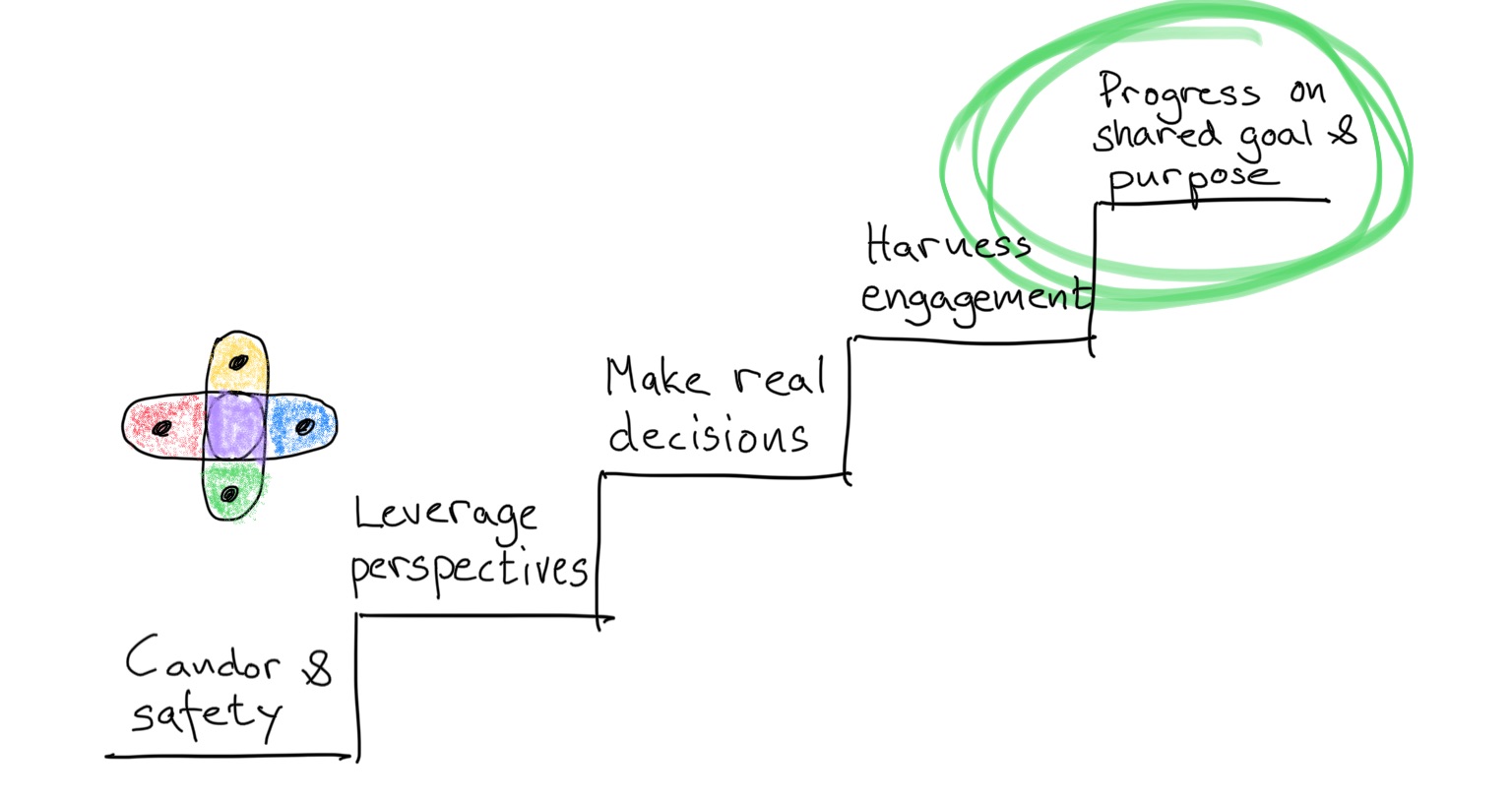 The end goal is to make progress on shared strategic goals. The rest of the model will give you a structure on how to get there – but before you do anything make sure that the team understands Why they are put together to collaborate and what the Goal is.
The end goal is to make progress on shared strategic goals. The rest of the model will give you a structure on how to get there – but before you do anything make sure that the team understands Why they are put together to collaborate and what the Goal is.
A shared goal and purpose creates the foundation for what I call a Transformational frame (strategic frame in the case study).
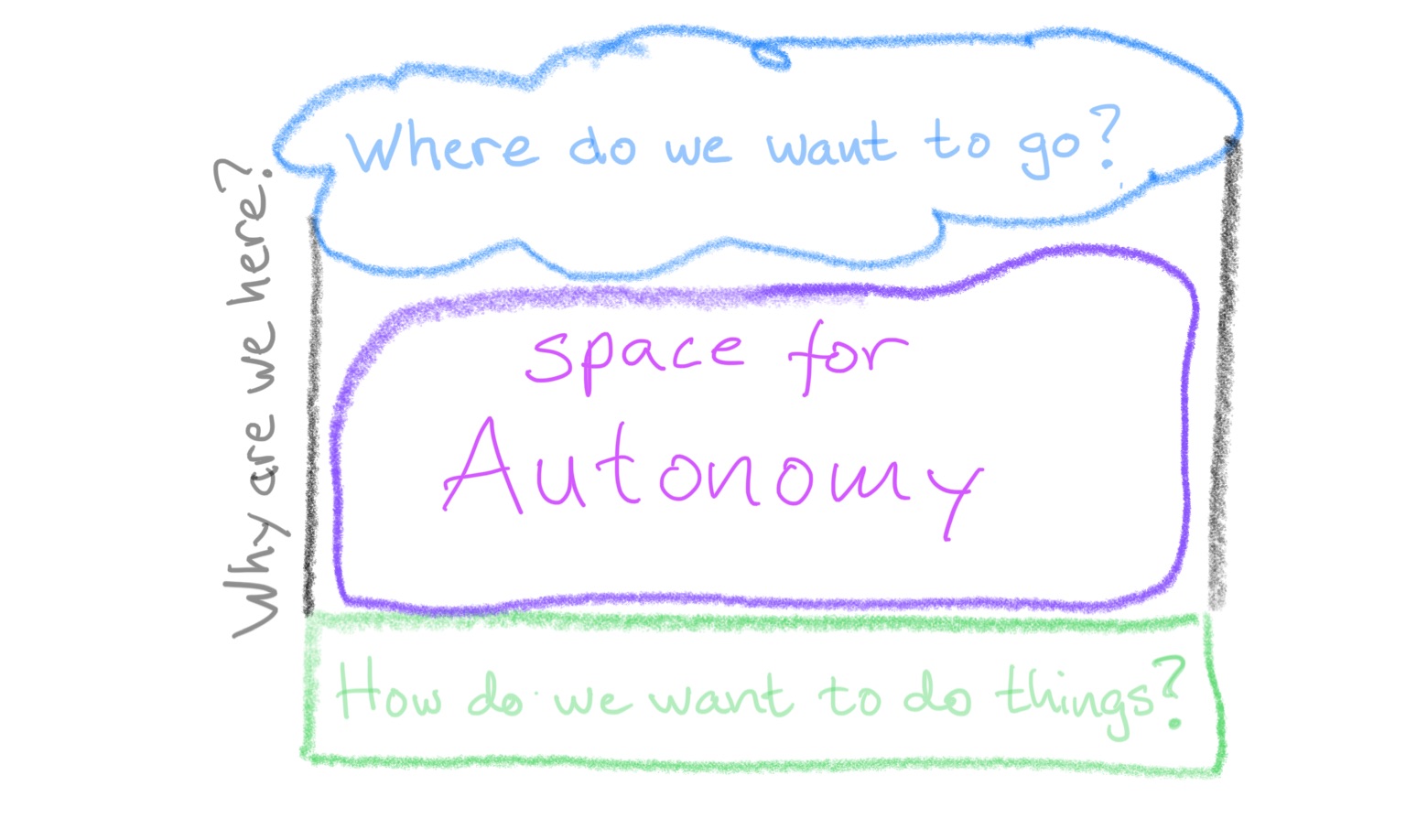 With this frame the team can be autonomous and creative about how to reach the shared goal. Autonomy is the key to the motivation and engagement needed to realise goals in a rapidly changing environment.
With this frame the team can be autonomous and creative about how to reach the shared goal. Autonomy is the key to the motivation and engagement needed to realise goals in a rapidly changing environment.
The frame also makes it easier for team members to suggest new ideas (that fit with the frame) and argue their point. This is key for a Psychologically safe atmosphere …. Which takes us to the first fundamental step of the model:
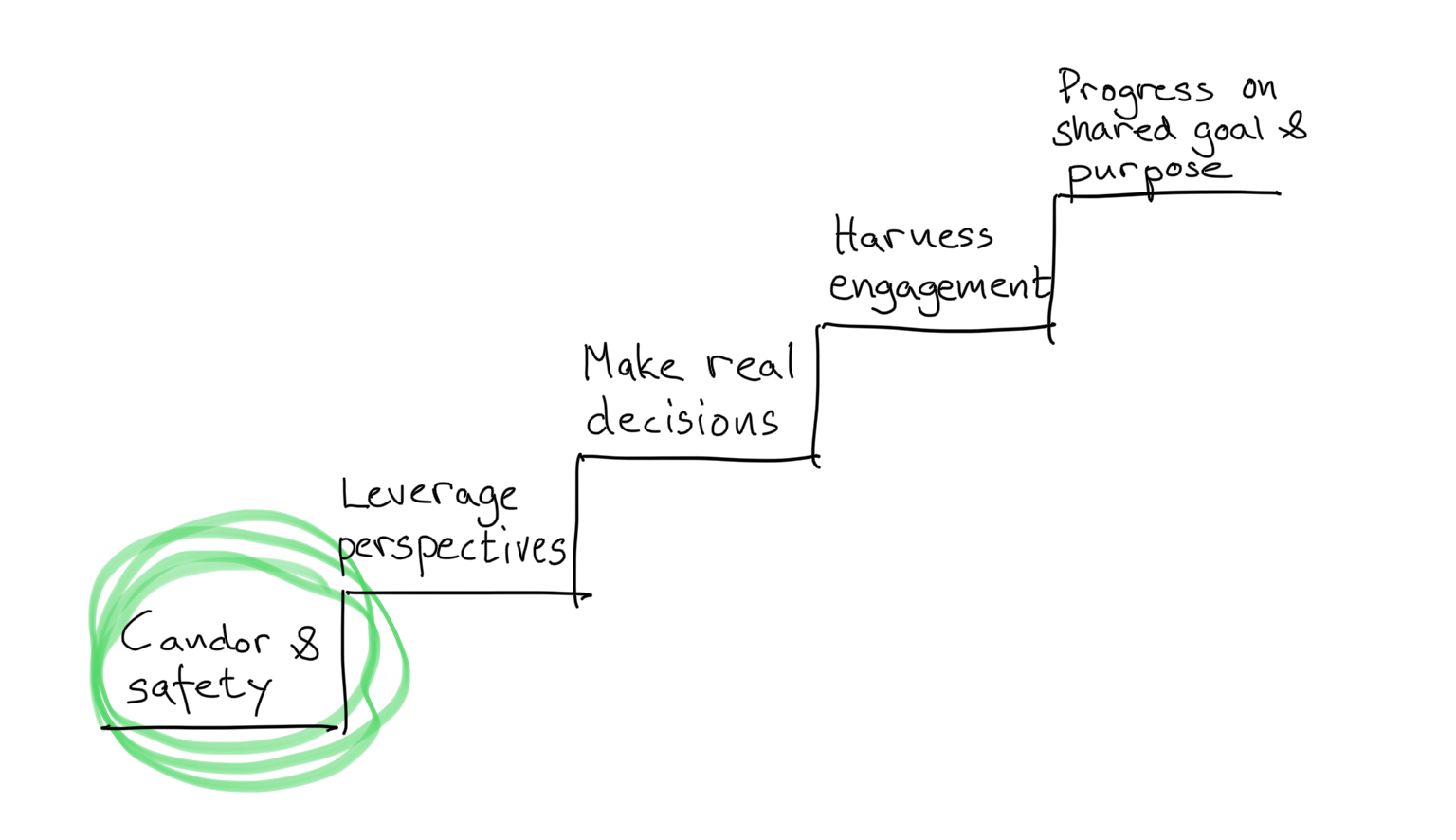 To make progress on a complex challenge we need the best and most accurate information on the table. Therefore team members need to commit to acting with candour by:
To make progress on a complex challenge we need the best and most accurate information on the table. Therefore team members need to commit to acting with candour by:
- Sharing new, even sensitive, information and insights
- Asking thoughtful questions
- Challenging old truths and ways of thinking/working
- Being open about not having all the knowledge and answers (while being eager to learn)
This is easier for some people then others, and to maximise chances of other people not holding back questions and information everyone on the team must commit to co-creating what Amy Edmondson (Harvard Business School) calls a Psychologically safe atmosphere where people dare to take interpersonal risk, despite feeling uncomfortable.
I usually say that we need to get comfortable being uncomfortable and I’ll share tips on how that can be done in coming posts. But for now, let’s go to the next step.
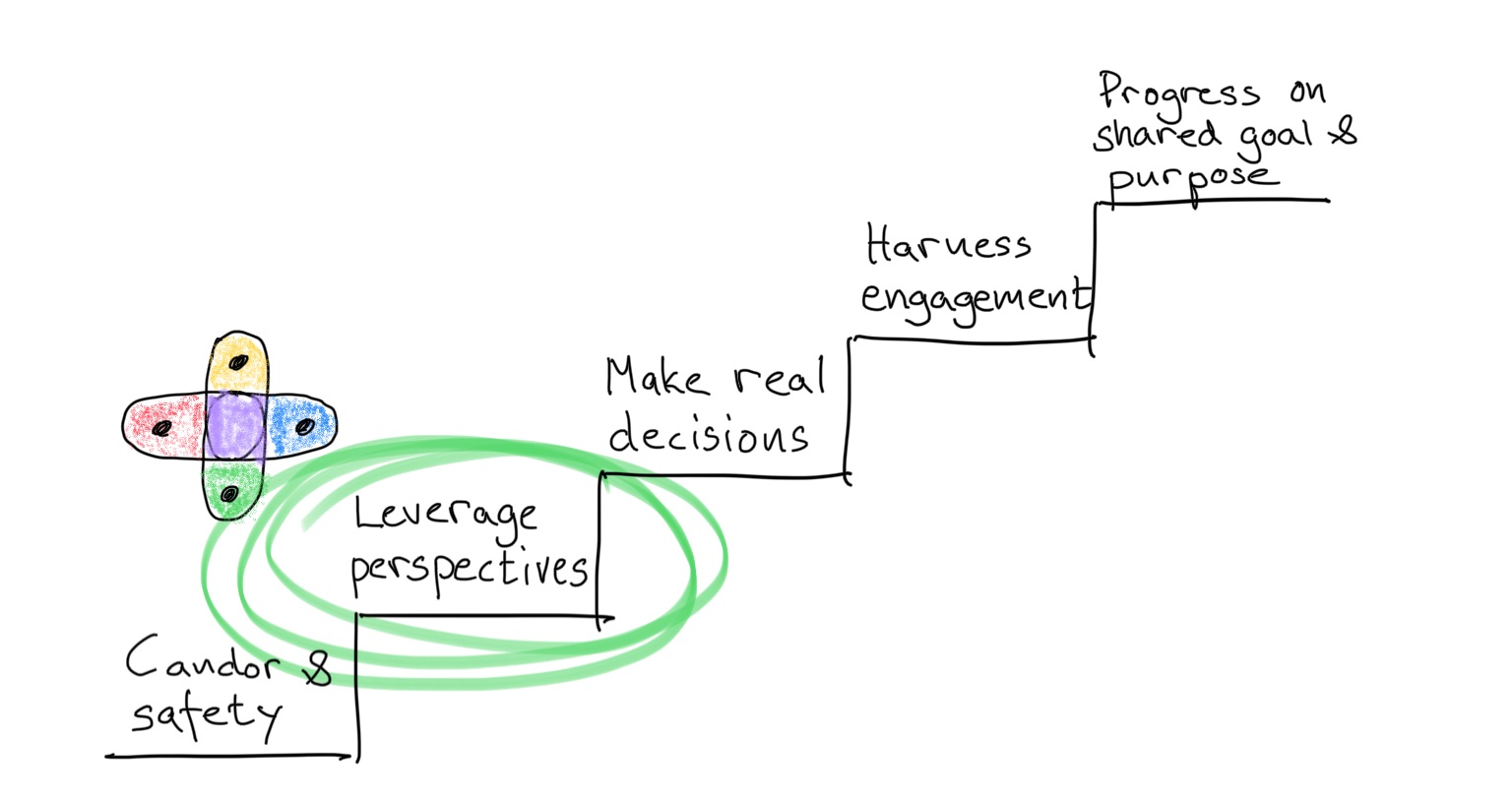 If we get the first step right we will get the right questions and information on the table. The second step is all about how we attend to that information.
If we get the first step right we will get the right questions and information on the table. The second step is all about how we attend to that information.
Teams that make progress on complex challenges know that the best ideas occur after looking at the challenge from several different perspectives. The team also sees disagreement as something good and instead of going into debate about what is right and wrong (on complex topics there is by definition not one right answer) they go into dialogue where they try to see the topic from eachoters perspectives. Also, they often go outside of the team to take in even more perspectives. All, in the service of getting as much updated, high quality, data into their idea generation process as possible.
They also know that collective intelligence will not be utilised if they only talk about the information and knowledge they all have in common.

Therefore they take time for each person to bring in their unique knowledge, experience and perspectives on the challenge ….
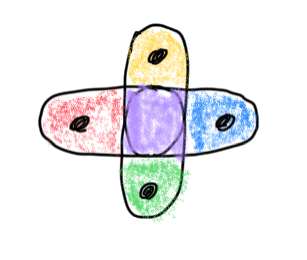
….before moving on to idea generation and decision making.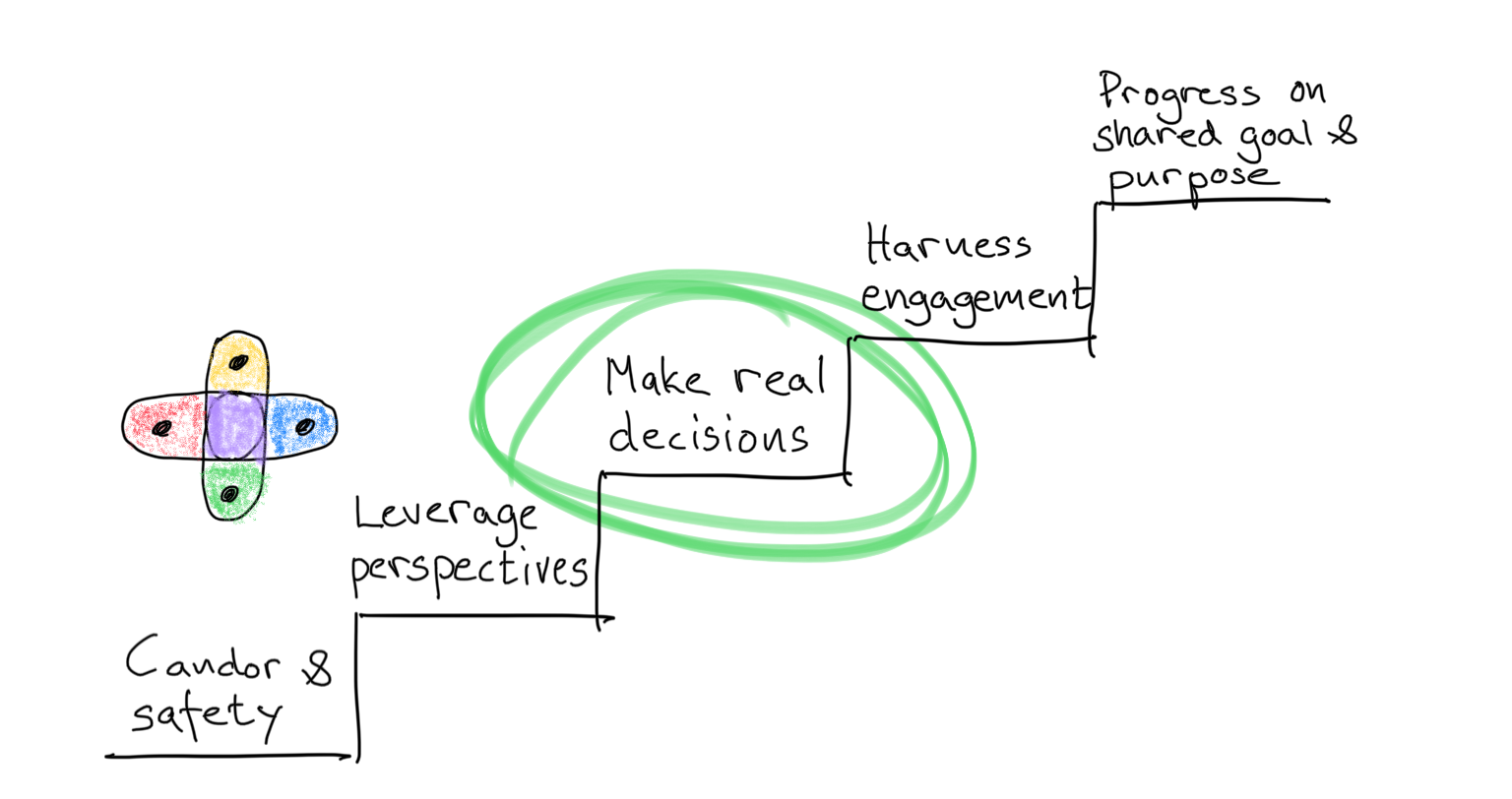
By definition a complex challenge offers several ways to move forward, but not one right answer. If you have a diverse team you hopefully have lots of ideas and suggestions and hopefully everyone will not agree. But in the end, to gain and maintain speed, you need everyone to commit and act in accordance with the decisions that the team makes.
A fact about decisions in a complex environment is that they will not be 100% right (unpredictable future is one definition of complexity) hence there will have to be some improvisation and adjustments to make the decision work. Sometimes a lot of improvisation.
 This means that some people will have to get behind and and improvise around a decision that they did not think was the best idea to start with. This is hard, and it is more common to get into a situation where people say “I told you so” which will harm team chemistry, minimise constructive improvisation and insure slow progress, not only on this decision but on the teams over-all progress towards their goal and strategy.
This means that some people will have to get behind and and improvise around a decision that they did not think was the best idea to start with. This is hard, and it is more common to get into a situation where people say “I told you so” which will harm team chemistry, minimise constructive improvisation and insure slow progress, not only on this decision but on the teams over-all progress towards their goal and strategy.
To maximise chances of everyone engaging in improvisation to achieve a positive outcome from a decision (this is what I mean with a Real decision) you want to make sure 2 things happen:
- Everyone needs to voice what they think is the best way forward, and why.
(If you keep your opinion to yourself, chances goes up that you will feel/say “I toold you so” when things don’t go according to plan)
The teams Psychologically safe atmosphere, combined with giving everyone time to speak up, usually ensures this. - Each person needs to feel that the others have taken her/his suggestion and reasoning into account before the final decision is made.
Perspective taking, the first skill of the Leadership Backbone, combined with time to ask thoughtfull questions can usually ensure this.
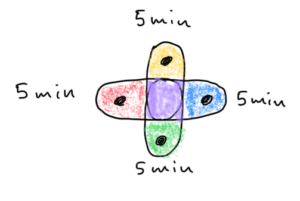
(if you feel your point of view was ignored the chance of creating a “I told you so”-mindset goes up a lot)
Once all perspectives have been voiced and listened to the team should go to decision making. It’s a good idea to decide that one person (might or might not be the team leader) is responsible to conclude and make a decision once all perspectives has been taken into account.
Too many teams aim to find consensus [Trap to avoid] on complex topics, but that often [1] takes a vast amount of time and [2] ends up in a sub-optimal compromise between 2-3 good ideas. On complex challenges we need to find a good decision (by definition there will be several good options) and move on.
It helps that everyone on the team knows that in a complex world there are multiple ways forward and that it is nothing personal that your idea is not the one that gets selected every time.
Also, they know that it is important to make decisions to keep moving forward, and that the team’s candor and safe environment will ensure that we can adjust and improvise if the decision that gets taken does not generate the effect we hoped that it would.
 The fourth step in the model is to harness the engagement that we have created from [1] having a shared goal and purpose and [2] from the process of coming up with ideas and decisions.
The fourth step in the model is to harness the engagement that we have created from [1] having a shared goal and purpose and [2] from the process of coming up with ideas and decisions.
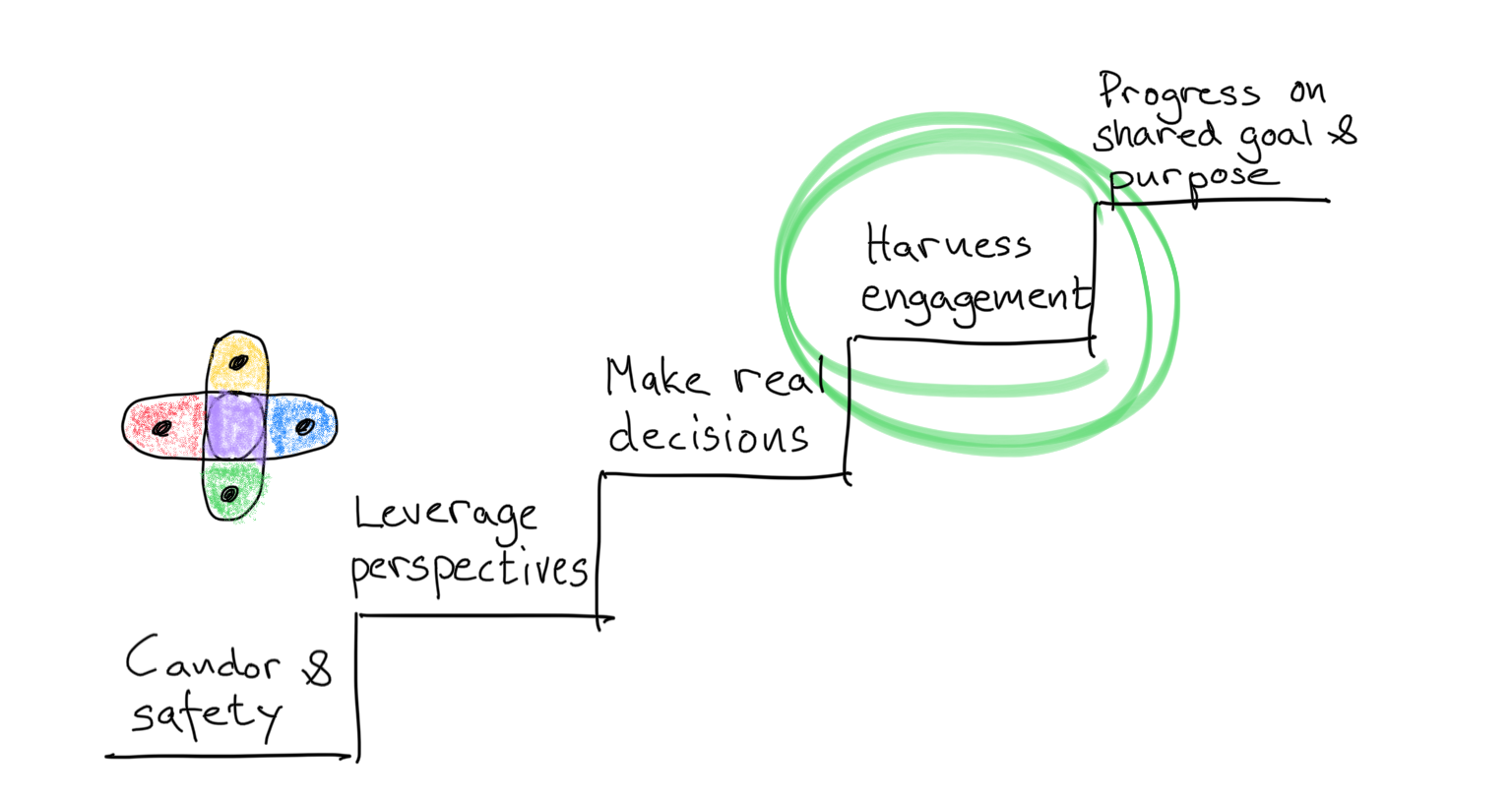 We will not go into this in detail in this post, but the agile literature is full of techniques on how we can use stand-ups, visualisation tools, goal-structures etc. to keep engagement and commitment to decisions high, and to ensure that we make progress towards our shared over-all goal.
We will not go into this in detail in this post, but the agile literature is full of techniques on how we can use stand-ups, visualisation tools, goal-structures etc. to keep engagement and commitment to decisions high, and to ensure that we make progress towards our shared over-all goal.
 OK, so that is the model. If you put a team together to work on a complex task, make sure you go through these steps. It will take some time in the beginning, but it will pay off in the end.
OK, so that is the model. If you put a team together to work on a complex task, make sure you go through these steps. It will take some time in the beginning, but it will pay off in the end.
Unfortunately, most teams and collaboration efforts do not go through these steps. Here is what typically happens when people are put together in a team or collaboration effort.
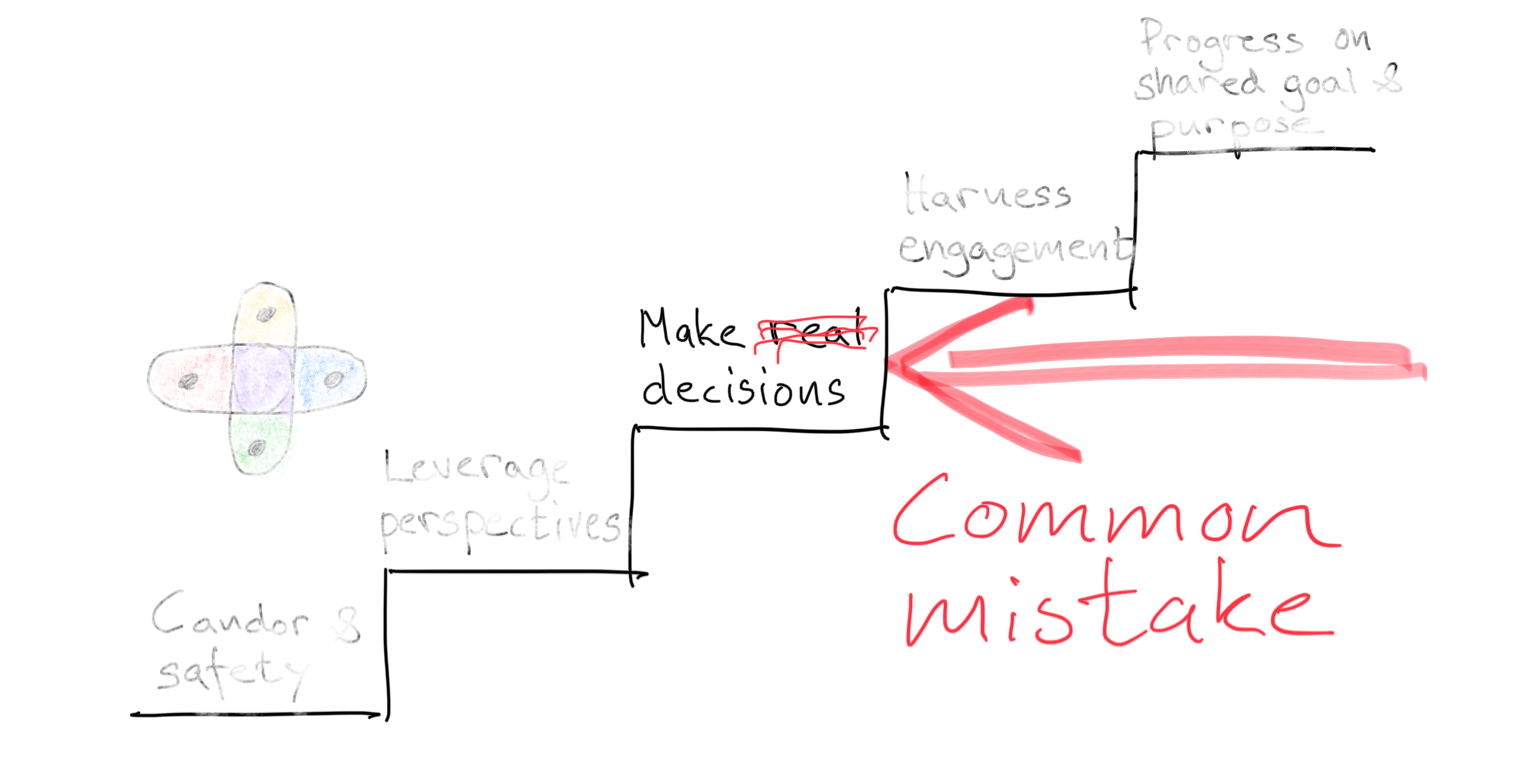 We start by making decisions, probably because it makes us feel productive and like we are accomplishing something.
We start by making decisions, probably because it makes us feel productive and like we are accomplishing something.
Unfortunately these decisions will not leverage the knowledge, information, experience and diverse competence of the team because typically there will be team-members who will not speak up as they are still trying to understand the goal and purpose of what we are doing, and/or because they do not feel safe to voice the information and questions that they have.
These decisions will not be loaded with the engagement we need and therefore the necessary adjustments and improvisation does not happen, or it happens late in the process.
By this time the team has usually wasted a lot of weeks and months on unproductive work, which has usually caused feelings of frustration hence team chemistry will usually be quite low and the team will be further away from reaching their goals then they where on day one.
To make things worst, under these unfortunate circumstances a cross-functional team with diversity regarding expertise, experience and knowledge will most likely start having unconstructive debate. Also, there is great risk of sub-grouping where the different groups and individuals say things like “ she is a nice person but she just doesn’t understand….” and when things don’t go according to plan (which is always 100% certain in complexity) there will often be a lot of finger pointing and defensiveness.
Unfortunately this seems to be what happens in most organisations trying to move to an Agile organisation model or when an organisation tries to add new competences to their management teams or C-suite in order to meet the challenges of a changing business environment. The end result is often stagnation and poor performance.
OK, that’s enough gloomy talk. What I want to say is that if you, like most organisations, are not getting what you need out of your management team or Agile transformation, make sure to work on your Leadership Backbone skills and put them to use by following the structure of this Leadership Backbone model.

